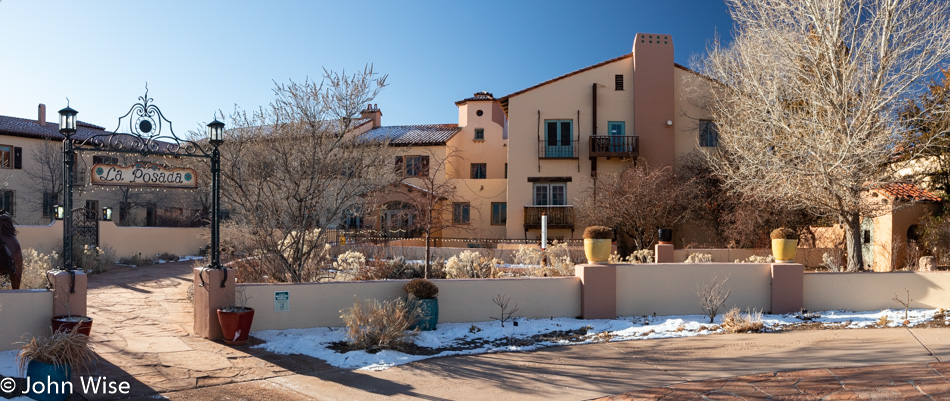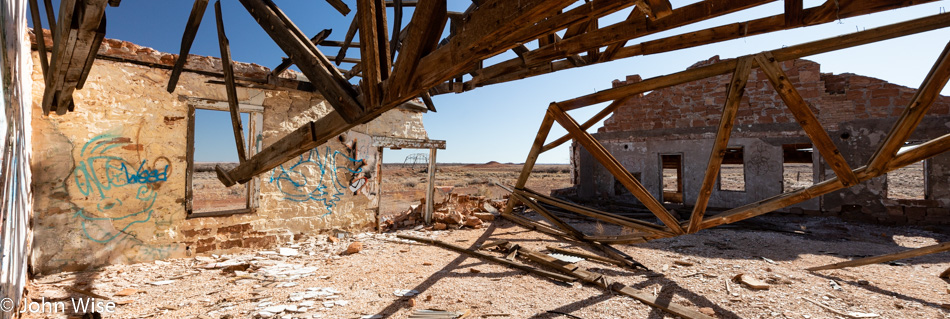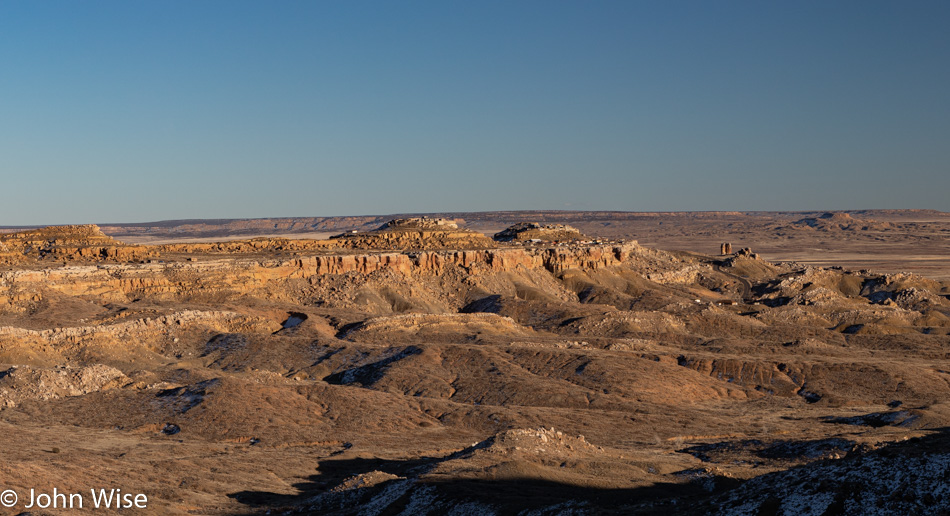
La Posada Hotel opened 90 years ago in 1930 and closed only 27 years later in 1957. For a while, the building served as offices for the Santa Fe Railway, but they moved out in 1994, and it looked like the building would be demolished. Now renovated and operating again, we are finally spending a couple of nights here. In the past, this iconic property designed by Mary Jane Colter has seen Albert Einstein, Amelia Earhart, President Franklin D. Roosevelt, Howard Hughes, John Wayne, Douglas Fairbanks, Clark Gable, James Cagney, and many more celebrities all stay here.
Being at La Posada in the off-season on a quiet Friday night lends tragedy to the experience. I’m sure that during the main season they must be doing well as at other times we looked to book a room the place was sold out. All the same, while this historic relic from the past is still operational, it was a decline in rail travel back in the late 1950s that forced the closure of the hotel.
Walking in this building today, it’s easy to imagine the excitement of America’s well-to-do rubbing shoulders with some of the famous guests and marveling at the difference in architecture and landscape from what they were accustomed to back east. Today, everyone has seen “Marlboro Country” in car and cigarette ads along with sci-fi movies, so they no longer need to be here for the in-person experience. In the age of Instagram, only the moment captured in the right pose with perfect lighting has any value, while experiencing the architecture, ambiance, and history of a place won’t do much to attract followers.
Influencers don’t need stories steeped in the minutiae of geography, biology, design, or history. They need to convey urgency to consume, capture, and move on, as the next great thing is only a click away. This, though, is not the way many of us wish to live. Sitting down for an extended dinner instead of hitting the drive-thru and having the wherewithal to sit quietly to read, craft, or explore one’s inner dialog instead of heading to a room to watch TV is a disappearing art.
This nostalgia for an age I didn’t live in often feels misplaced in that I’m trying to somehow own it or over-romanticize what it might have actually been. The fact is what I take from my perception of the heyday of these outposts here in the southwest is that they represent a kind of ancient internet of sorts. Novelty was in full swing, and finding your way to such an exotic location that was like nothing found in Europe or the American Northeast meant that you’d arrived. Without video, streaming media, or even high-quality color reproductions, the average person never really had great impressions of what they might find before getting there and witnessing it with their very own eyes.
Exploration and discovery were still easily found, and real astonishment could be had. By today’s standards, La Posada is hardly a luxury hotel, but in 1930, as a destination to a giant, colorful land of exquisite sights, it was the height of superlatives. This ability to find novelty from a relative perspective of naivety is now long gone.

Consider the emotion of love and its connection to discovery. Is the child’s bond with its parents amplified due to the adult being the primary source of helping the child learn about and explore its world? Or what about the first love of young adults as they begin the discovery of sensuality through the intimate exploration of another person? How does love foster greater sharing and deeper learning? Why, when holding hands driving down the lonely highway, is the view ahead magnified into something possibly greater than it might have been otherwise?

If there is an emotional and intellectual basis that arises out of learning, love, discovery, and exploration, how are young people who are isolated from loving community relationships supposed to develop personas that care about other individuals? Are we creating sociopaths from the insulating routines of lone play, electronic communication, and solo exploration? What happens when the individual is more concerned with moments of self-love instead of group identity and harmony?

Without a plan but having a good sense of where we are, the decision to wander was an easy one. Our first thought was heading to Leupp after our server last night told us of the flea market up there, but then this morning, a different server told us she thought there was a flea market in Dilkon. Instead of choosing one or the other, we decided to head over to Dilkon first and then loop around to Leupp afterward. Both villages are on the Navajo Reservation.

By the time we arrived in Dilkon, there was only one table set up, so we knew we were too early. Instead of waiting around we pointed the car west and kept on driving. The flea market in Leupp was going full blast, and as luck would have it, we were now approaching lunchtime and had enough appetite to make the stop worthwhile.

Smoke is an important factor in deciding which vendor we visit first, as our primary interest today is roast mutton, and an open wood fire is the only way to properly grill mutton and green chili. Today was going to be different as the family that was cooking our lunch was preparing the bread right over the fire instead of frying it in lard.

We are here so rarely there is no chance of forsaking indulgence by being reasonable. From roast mutton, we went to a trailer where another family was offering mutton stew with steamed corn. We started to smell of mutton ourselves, and just as greasy as either dish, we weren’t done yet. A couple of older ladies had Navajo Cake on offer, along with other corn-based treats we stocked up on. Then, it was back to the first family, where they had a form of ach’íí on offer. Traditionally, this item is mutton fat wrapped in sheep intestine and grilled, but this variation was chunks of liver and diced intestine fried in mutton fat and then cooked as a stew. Caroline enjoyed this far more than I did; after one taste, I deferred to her, but by now, we were stuffed, so she ended up sharing the last small bit with one of the rez-dogs wandering around.

Next to the empty lot where the weekly flea market gathers is the ruin of the Sunrise Trading Post. Not far from the Little Colorado River, this trading post opened in 1920 and ceased operations in 1985.

Like a flip of the coin, we took the next paved road north that brought us up to the Hopi Reservation. There are not a lot of opportunities to stop next to the road to check out the area, so we mostly just stop right in the street. With long stretches of road offering a clear sight of things ahead and behind, we can easily handle the odd approaching vehicle, but we also can’t wander far from the car. So we drive slowly, but we keep going, admiring the stark landscape as we crawl along.

The first Hopi village we come to is Kykotsmovi and it has a small shop and gas station. This is weird; we’re the only white people here. Okay, it’s not that weird; as a matter of fact, it seems to be the norm as this isn’t our first visit to a reservation. This place was busy, with two registers going and a line for each. We leave with a couple of drinks and an ice cream because we are traveling, and indulgence is our middle name. What was noteworthy was the pheasant pelt we bagged. For only $10, with its head still attached but its guts removed, we leave with the feathers of a beautiful specimen that Caroline says will become part of some crafty thing or other.
We ventured up some pavement that turned to dirt which we weren’t feeling today, so back to Highway 264 across Hopi lands until we reached the Hopi Cultural Center, which felt like a good place to stop for a coffee. Caught up with a bit of writing, transferring photos, and Caroline finishing some crocheting, we were again heading down the road to other places.

Our first stop on our way back towards Winslow was at Tsakurshovi Gallery, and were happily greeted by Janice, who owns the place and shares it with her husband Joseph, who was napping. We’d not seen these two in years, and while it would have been nice to say hi to Joseph, too, it was great just learning that they were doing well.
Caroline eyed a bracelet and some earrings that were talking to her, and seeing they’d now represent a wonderful moment surrounding our anniversary weekend, the splurge felt well deserved. This thought of splurging, though, would be disingenuous if I weren’t honest in admitting that everything else about our stay up north is indulgent, too. From the luxury of the historic La Posada Hotel and the exquisite food at the Turquoise Room, where we’ll be again tonight, to the Leupp Flea Market, where we were able to eat absolutely unique foods we cannot get anywhere else.

And this has been our day. Out in a vast open landscape where many would argue there’s nothing to do, we moved into a countless number of impressions that feel exceptional, and if it weren’t for our familiarity with these places, I’d say it is all quite rare for most people.